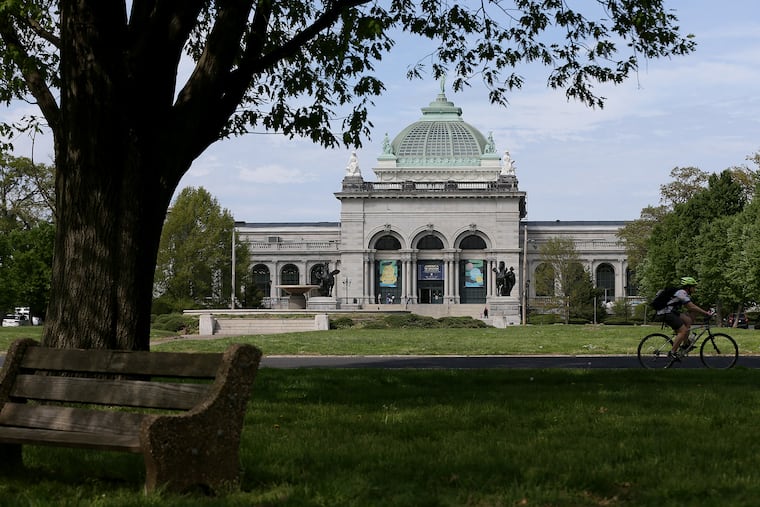What happened to the buildings from the 1876 Centennial in Fairmount Park?
The exposition on the banks of the Schuylkill — the first World’s Fair in the United States — featured some 200 buildings. Just two remain.

After years of planning, the Centennial Exposition marking the 100th anniversary of the nation’s birth opened in Fairmount Park on May 10, 1876, with President Ulysses S. Grant and a long list of dignitaries in attendance.
Set on 286 acres on the banks of the Schuylkill, the exposition — the first World’s Fair in the United States — featured 200 buildings representing 37 countries, as well as states and territories of the still-growing country.
By the time it ended on Nov. 10, nearly 10 million people had visited, according to organizers.
Then, one by one, the buildings large and small that dotted the landscape disappeared. Only two main structures remain — Memorial Hall (the home of the Please Touch Museum) and Ohio House (most recently the Centennial Cafe).
Why were most of the buildings demolished? A reader asked through Curious Philly, a forum where readers submit questions and our journalists seek to answer them.
Not built to last
With a few exceptions, the buildings weren’t meant to be permanent, said Linda Gross, co-author with Teresa Snyder of Philadelphia’s 1876 Centennial Exhibition.
Those originally intended to remain were among the larger structures, including Memorial Hall and the now-demolished Horticultural Hall.
“The Main Building was slated to be razed, but the International Exhibition Co., led by Clement Biddle, worked to create a permanent exhibition in Fairmount Park,” Gross, a research librarian at the Hagley Museum in Wilmington, said in an email.
The building — the largest in the world at the time, covering 20 acres — reopened May 10, 1877, as the International Exhibition Co., later the Permanent Exhibition Co.
But, as Elizabeth Milroy writes in The Grid and the River, the Fairmount Park Commission did not want the building to remain, and in 1879 ordered it vacated “on the grounds that the new managers now emphasized entertainment more than edification.” The operators resisted. but gave up after they started losing money. The building was demolished in 1881.
Horticultural Hall was chosen to remain, Gross said, in part because it had central heat and a good lighting system. “It remained as a botanical conservatory for many years,” she said.
But it fell into disrepair and was demolished in 1955 after suffering major damage from Hurricane Hazel in October 1954. Even before the hurricane hit, the hall had been closed to the public due to structural concerns.
After the fair, Memorial Hall became the home of the Pennsylvania Museum and School of Industrial Art, precursor to the Philadelphia Museum of Art, Gross said. The Art Museum moved in 1928 to the Benjamin Franklin Parkway, but Memorial Hall continued to house art until the Fairmount Park Commission took over the building in 1958. In 2008, it reopened as the new home of Please Touch after a three-year, multimillion-dollar renovation.
New homes and purposes
Many of the smaller buildings found new purposes, thanks in part to a U.S. Supreme Court ruling.
When the fair ended, it appeared that the event had turned a profit. But then the court ruled that the $1.5 million Congress had allocated for the event ($36.3 million in 2019 dollars) was a loan that had to be paid back.
Organizers looked to pay back the loan in part by selling off buildings, many of which were made for quick assembly — and disassembly.
Several dozen buildings from the fair were moved to the then-burgeoning New Jersey Shore, according to a 1976 New York Times story.
One of them, said to be Froebel’s Model Kindergarten, possibly became St. Peter’s by-the-Sea Episcopal Church in Cape May Point. Its portability is underscored by the fact that its current location follows four moves as the shoreline retreated over the years, according to the church history.
It is also said that the Pennsylvania Railroad bought a building and first used it at the Wayne station and then moved it to Strafford, where it still stands as a Regional Rail station.
Of at least four buildings moved to Spring Lake, Monmouth County, two remained in 1976, the Times reported: the Missouri House, which was a rooming house before becoming a private residence, and the Portuguese House, which was then part of the Billows Hotel. Both are now gone.
Bits and pieces of other Centennial Exposition buildings may have ended up in other structures.
For example, according to the Times, Richard J. Dobbins, who built most of the buildings, bought back at least a dozen of them, as well as some of the lumber from Agricultural Hall. He used all that wood to put up about 40 farmhouses in Monmouth County, as well as fences, bridges, and bulkheads.
Still on display
Exhibits from the fair also live on.
After the exhibition, 62 boxcars of material were taken to Washington, where some of the money paid back to Congress was allocated for the U.S. National Museum, now the Arts and Industries Building of the Smithsonian Institution.
From 1976 until 1996, the museum displayed part of the Centennial collection.
Gross said pieces from the Smithsonian’s exhibition are on loan to the National Museum of Industrial History in Bethlehem, Pa. The museum says it has 19 artifacts from the Centennial on exhibit there.
» READ MORE: $5 million improvement to Fairmount Park could signal revival in Parkside
» READ MORE: A hidden trolley network in Fairmount Park is set for revival
» READ MORE: ‘A labor of love’: The lives of Boathouse Row’s little-known inhabitants